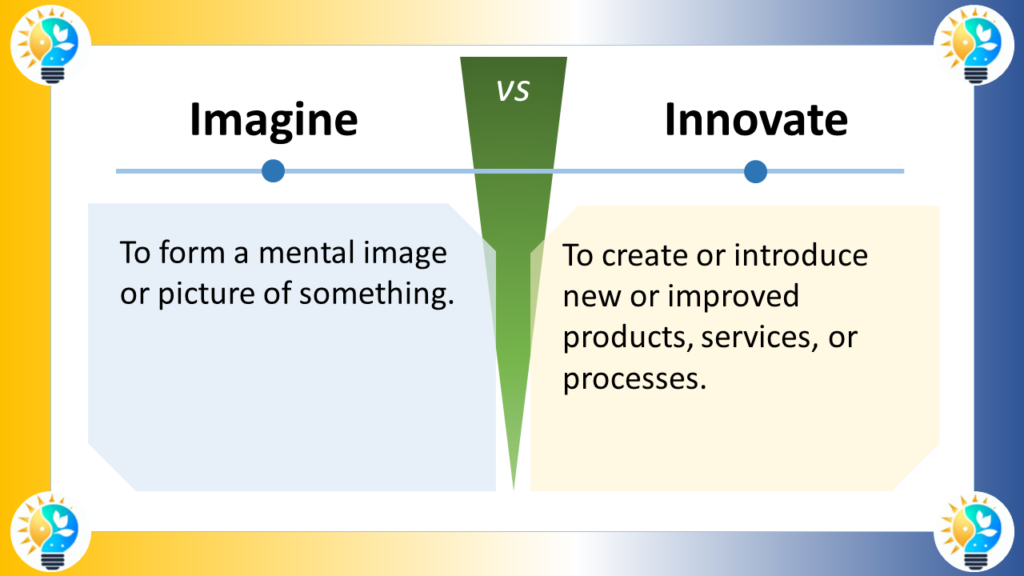Innovation and imagination are both crucial to the creative process, yet they serve distinct roles.
Innovation involves the implementation of new ideas, while imagination is about the creation of those ideas.

Definition
Innovate
Innovation refers to the process of creating new methods, ideas, or products that bring significant changes or improvements to their respective fields.
Characteristics of Innovation:
- Implementation: Involves putting ideas into practice.
- Improvement: Aims to enhance efficiency, effectiveness, or aesthetic values.
- Impact: Often leads to measurable progress in a specific industry or sector.
Imagine
Imagination is the ability to form new images or concepts not present to the senses.
Characteristics of Imagination:
- Creativity: The power to transcend traditional ideas to create meaningful new ideas.
- Freedom: Unconstrained by external realities.
- Exploration: Can explore limitless possibilities without the need for immediate practical application.
More Synonyms on innovation, innovate and innovative:
- Adapt
- Advance
- Change
- Create
- Cultivate
- Devise
- Develop
- Discover
- Disrupt
- Evolve
- Experiment
- Fashion
- Generate
- Imagine
- Initiate
- Introduce
- Invent
- Modernize
- Originate
- Pioneer
- Progress
- Prototype
- Radicalize
- Reform
- Reinvent
- Renew
- Revolutionize
- Restructure
- Set Trends
- Transform
- Upgrade

Innovation is considered as a driving force in progress.
It includes the introduction of novel ideas, methods, or products that bring positive change and advancement.
For more information about innovations, check our glossary
Relationship and Relevance
Imagination is the bedrock of innovation. It allows individuals to think beyond the existing constraints and envision what could be possible. Innovation, on the other hand, applies these imaginative ideas to create real-world solutions and advancements. Without imagination, innovation would lack creativity and vision; without innovation, imaginative ideas would remain unapplied and theoretical.
Based on the search results provided, the key differences between innovation and imagination are:
Imagination is the ability to form new ideas, concepts or mental images in the mind. It is the capacity to envision things that do not currently exist. [3]
Innovation is the process of taking those imaginative ideas and making them real – turning them into new or improved products, services or processes. Innovation involves the practical application and implementation of creative ideas. [1][4]
In other words, imagination is the starting point – the “what if” and the dreaming. Innovation is the next step – the “how to” and the doing. Imagination sparks the initial idea, while innovation brings that idea to life. [1][4]
Some key points:
- Imagination is about envisioning possibilities, while innovation is about making those possibilities a reality. [3]
- Imagination is the creative process, while innovation is the practical application of that creativity. [1][4]
- Imagination is the “what might be”, while innovation is the “what can be”. [3]
- Imagination is the foundation for innovation – it provides the ideas and inspiration that innovators then work to develop and implement. [1][3][4]
So in summary, imagination is the ability to conceive of new ideas, while innovation is the ability to turn those ideas into real-world solutions and improvements. They are closely linked, with imagination leading to innovation. [1][4]
Context for Using Each Term
- Innovate: Used when discussing the application and implementation of ideas in practical settings, especially in technology, business, and science.
- Imagine: More frequently used in artistic, academic, and theoretical discussions where the generation of ideas is more valued than their practical application.
Example of Utilization
Innovate
A tech company develops a new smartphone with a foldable screen, significantly altering how users interact with their devices. This innovation not only improves the product but also impacts the market and consumer habits.
Imagine
An author conceptualizes a science fiction universe where humans can transfer their consciousness to machines. This act of imagination explores themes of identity and technology without the immediate need to turn these ideas into reality.
FAQ
Q: Can innovation exist without imagination?
A: No, innovation fundamentally requires imagination to generate the ideas that are subsequently developed and implemented.
Q: Is imagination always followed by innovation?
A: Not necessarily. Imagination can occur purely for artistic, theoretical, or recreational purposes without leading to practical applications.
Q: Are innovation and imagination restricted to certain fields?
A: No, both concepts are universal and can be applied across all disciplines, though they are emphasized differently depending on the field.
Understanding the nuances between innovate and imagine can significantly enhance how we value and engage with various aspects of creativity and development.
[1] LinkedIn – Imagineering and Innovating
[2] Krista Howell Education Portfolio – Creating, Imagining, and Innovating
[3] NLM Director’s Blog – Imagination: The Cornerstone of Innovation
[4] LinkedIn – Innovation and Imagination in Motion
[5] The Thinking Stick – Imagine, Create, Innovate

